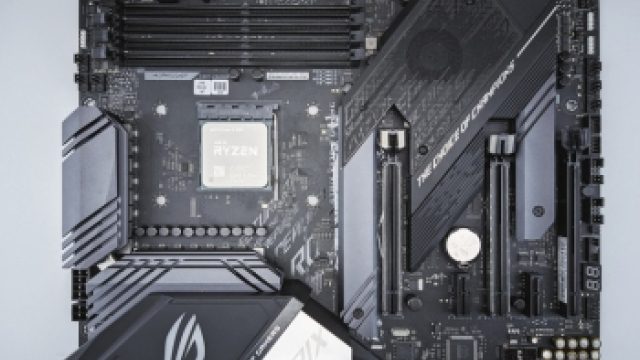Micro ATX and Mini ITX are two popular form factors in the world of computer motherboards. As the heart of any PC, the choice between Micro ATX and Mini ITX can significantly impact your system’s size, performance, and expandability.
Both offer unique advantages and limitations, catering to different user needs and preferences. In this comparison, we’ll delve into the key differentiators of Micro ATX and Mini ITX, helping you make an informed decision when building your next computer.
What are Micro ATX and Mini ITX?
Micro ATX and Mini ITX, two popular form factors in the world of motherboards, are the driving force behind compact PC builds.
These compact alternatives differ significantly from the standard ATX form factor, offering unique advantages and limitations for builders seeking smaller, yet powerful systems.
Micro ATX emerged in the late 1990s as a response to the need for smaller motherboards while maintaining compatibility with ATX cases.
It retained the same width as ATX but reduced the length, making it ideal for space-conscious enthusiasts. On the other hand, Mini ITX, pioneered by VIA Technologies in 2001, took a step further and became the smallest mainstream form factor. Its diminutive size opened up new possibilities for ultra-compact, energy-efficient builds.
Size and Dimensions
When it comes to size, the disparities between Micro ATX and Mini ITX are evident. Micro ATX usually measures around 9.6 inches square (244mm x 244mm), while Mini ITX is significantly smaller at 6.7 inches square (170mm x 170mm). These seemingly minor differences have a profound impact on case compatibility and portability.
Micro ATX’s larger dimensions make it more compatible with a broader range of cases, including many mid-tower and some compact options.
Mini ITX, with its compact size, is incredibly versatile, fitting into small form factor cases with ease. This makes it a go-to choice for building HTPCs (Home Theater PCs) or portable gaming rigs where space is at a premium.
Related Article: Will an ATX Motherboard Fit in an EATX Case? Explained
Expansion Slots and PCIe Support
Expansion slots are vital for adding extra components to a motherboard. Here’s how Micro ATX and Mini ITX stack up in this department.
Micro ATX typically offers more expansion slots, with the standard providing 4 slots. This makes it more suitable for multi-GPU configurations, additional sound cards, or other expansion cards that some power users may require.
In contrast, Mini ITX boards are more limited, usually featuring only one PCIe slot. While this may be a drawback for hardcore gamers or content creators who crave multiple GPUs, it forces builders to be selective with their component choices, ensuring only the most crucial components find their place within the compact confines.
RAM and Storage Options
RAM and storage capabilities play a vital role in determining a system’s overall performance and upgrade potential. Let’s explore the differences in this regard between Micro ATX and Mini ITX.
Both form factors generally offer similar RAM capacities, supporting the same DDR4 modules. Depending on the specific motherboard model, builders can equip their systems with generous amounts of RAM, facilitating multitasking and memory-intensive tasks.
The storage options are where we start to notice distinctions. Micro ATX boards typically come with more SATA ports, allowing for additional traditional hard drives and SATA SSDs. Mini ITX, however, compensates for this limitation with its M.2 slots, providing the opportunity for faster NVMe storage solutions.
Related Article: Micro ATX vs Mid Tower: Choosing the Perfect PC Case
Power Delivery and Cooling Solutions
Reliable power delivery and efficient cooling are essential for maintaining a stable and smooth computing experience. Here’s how Micro ATX and Mini ITX fare in these departments.
Due to its larger size, Micro ATX boards tend to have more robust power delivery systems. This means they can handle higher wattages and are better suited for power-hungry components like high-end CPUs.
Mini ITX, with its compact form, often requires more careful planning for cooling solutions. While both form factors can accommodate standard air and liquid cooling setups, the reduced space in Mini ITX cases may necessitate specific cooler choices and airflow considerations.
Performance and Versatility
Performance is a critical consideration when choosing between Micro ATX and Mini ITX. Both form factors can excel, but they cater to different use cases.
Micro ATX provides a balance between performance and expansion options. It suits those who need moderate space-saving benefits without sacrificing too much in terms of performance or versatility. Gamers, content creators, and everyday users will find Micro ATX builds well-suited for their needs.
Mini ITX shines in scenarios where space is limited, and portability is a priority. Its compact size makes it perfect for media centers, LAN parties, or as a secondary system. Additionally, it’s an excellent choice for users who desire a capable, energy-efficient machine that doesn’t occupy much desk real estate.
Building Experience and Ease of Use
When it comes to building, ease of use is paramount. Let’s see how Micro ATX and Mini ITX compare.
Building with Micro ATX motherboards is a relatively straightforward process, akin to building with standard ATX boards. The familiarity ensures a smoother experience, even for first-time builders.
Building with Mini ITX requires more precision and planning due to the limited space. Cable management and component positioning become critical, making it a more involved but rewarding process for experienced builders.
Price and Availability
Budget considerations can sway a builder’s decision between Micro ATX and Mini ITX. Let’s delve into pricing and component availability.
Generally, Micro ATX motherboards are more budget-friendly, partly because of their widespread adoption and the lower manufacturing costs associated with their size. Mini ITX boards, being a niche market, often come with a slight premium.
In terms of component availability, Micro ATX enjoys a broader selection. Compatibility with a wide range of cases and components means builders have more options to choose from. Mini ITX components, while becoming more prevalent, may have limited choices in certain categories.
FAQs About Micro ATX vs Mini ITX
Is Mini-ITX better than Micro-ATX?
Mini-ITX and Micro-ATX serve different purposes. Mini-ITX is smaller, making it ideal for compact builds with limited space.
On the other hand, Micro-ATX offers more expansion slots, making it better for users who need additional components.
Are Mini-ITX and Micro-ATX the same?
No, Mini-ITX and Micro-ATX differ in size and features. Mini-ITX is the smallest form factor, while Micro-ATX is larger and typically has more expansion options, such as additional PCIe slots.
Which is bigger, Micro-ATX, or Mini-ITX?
Micro-ATX is bigger than Mini-ITX. Micro-ATX motherboards typically measure 9.6 x 9.6 inches, while Mini-ITX measures 6.7 x 6.7 inches, making it the smallest of the two.
Does Mini-ITX fit in Micro-ATX?
No, Mini-ITX motherboards are smaller and designed to fit into cases specifically tailored to that form factor.
They will not fit correctly in Micro-ATX cases, which are larger and built for their respective motherboards.
Is Mini-ITX more expensive than Micro-ATX?
Generally, yes, Mini-ITX motherboards tend to be more expensive than their Micro-ATX counterparts.
The compact size and specialized features of Mini-ITX boards contribute to their higher price.
What is the full form of ITX?
The full form of ITX is “Information Technology eXtended.” It refers to a family of motherboard form factors that are smaller than the standard ATX size, designed to accommodate compact PC builds.
Is mATX good for gaming?
Yes, Micro-ATX (mATX) motherboards are suitable for gaming.
While they may not have as many expansion options as full-sized ATX boards, they still support powerful CPUs and graphics cards, making them a viable choice for gaming setups.
Why is it called Mini-ITX?
The name “Mini-ITX” stems from its small size and compact form factor.
The “Mini” denotes its diminutive dimensions compared to standard ATX motherboards, and “ITX” stands for “Information Technology eXtended,” the form factor specification.
Are Micro ATX cheaper?
Yes, Micro-ATX motherboards are generally more affordable than Mini-ITX or full-sized ATX boards.
Their smaller size often translates to lower manufacturing costs and can make them a budget-friendly option for users.
Why is Mini-ITX so expensive?
Mini-ITX motherboards tend to be more expensive due to their specialized design and smaller production volumes compared to mainstream ATX motherboards.
Additionally, manufacturers may incorporate premium features for users looking for compact high-performance systems.
Which motherboard size is cheapest?
Micro-ATX motherboards are usually the cheapest among the common motherboard sizes.
Their affordability and reasonable feature set make them a popular choice for budget-conscious users.
Is ATX cheaper than mATX?
Typically, ATX motherboards are more expensive than Micro-ATX boards.
ATX boards offer more expansion options and are larger, which can lead to slightly higher manufacturing costs. However, prices can vary based on brand, features, and market demand.
Final Thoughts About Micro ATX vs Mini ITX
In conclusion, the choice between Micro-ATX and Mini-ITX comes down to individual preferences and specific needs.
Micro-ATX offers a balance between size and functionality, making it suitable for a wide range of builds, including gaming setups.
It provides more expansion slots and tends to be more budget-friendly. On the other hand, Mini-ITX excels in compactness, making it perfect for small form factor builds where space is limited.
It sacrifices some features for size but can deliver impressive performance. Ultimately, users looking for expandability and versatility may lean towards Micro-ATX, while those seeking a compact and minimalist build may opt for Mini-ITX.


